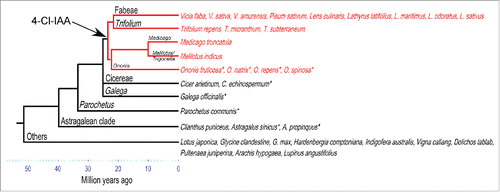Figures & data
Figure 1. Phylogeny of the major lineages of the inverted-repeat-loss clade (IRLC) of the family Fabaceae with a particular focus on the closest lineages to the tribe Fabeae. The ability to produce 4-Cl-IAA appears to have evolved after the divergence of the genera Cicer and Galega approximately 25 million years ago (indicated by arrow and red brances). Species with detectable 4-Cl-IAA are shown in red; species that do not have detectable 4-Cl-IAA are shown in black. Species investigated in this study are indicated by an asterisk. Phylogenetic relationships and divergence dates are taken from Choi. et al.,Citation14 Lavin et al.,Citation9 Schaefer et al.Citation10 and Wojciechowski et al.Citation8

Table 1. Endogenous levels of 4-Cl-IAA and IAA in 15 representative species from the family Fabaceae. (n.d., not detected).
